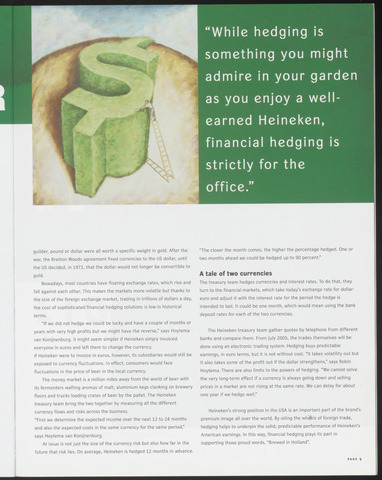While hedging is
something you might
admire in your garden
as you enjoy a well-
earned Heineken,
financial hedging is
strictly for the
A tale of two currencies
guilder, pound or dollar were all worth a specific weight in gold. After the
war, the Bretton Woods agreement fixed currencies to the US dollar, until
the US decided, in 1971, that the dollar would not longer be convertible to
gold.
Nowadays, most countries have floating exchange rates, which rise and
fall against each other. This makes the markets more volatile but thanks to
the size of the foreign exchange market, trading in trillions of dollars a day,
the cost of sophisticated financial hedging solutions is low in historical
terms.
"If we did not hedge we could be lucky and have a couple of months or
years with very high profits but we might have the reverse," says Hoytema
van Konijnenburg. It might seem simpler if Heineken simply invoiced
everyone in euros and left them to change the currency.
If Heineken were to invoice in euros, however, its subsidiaries would still be
exposed to currency fluctuations. In effect, consumers would face
fluctuations in the price of beer in the local currency.
The money market is a million miles away from the world of beer with
its fermenters wafting aromas of malt, aluminium kegs clanking on brewery
floors and trucks loading crates of beer by the pallet. The Heineken
treasury team bring the two together by measuring all the different
currency flows and risks across the business.
"First we determine the expected income over the next 12 to 24 months
and also the expected costs in the same currency for the same period,"
says Hoytema van Konijnenburg.
At issue is not just the size of the currency risk but also how far in the
future that risk lies. On average, Heineken is hedged 12 months in advance.
"The closer the month comes, the higher the percentage hedged. One or
two months ahead we could be hedged up to 90 percent."
The treasury team hedges currencies and interest rates. To do that, they
turn to the financial markets, which take today's exchange rate for dollar-
euro and adjust it with the interest rate for the period the hedge is
intended to last. It could be one month, which would mean using the bank
deposit rates for each of the two currencies.
The Heineken treasury team gather quotes by telephone from different
banks and compare them. From July 2005, the trades themselves will be
done using an electronic trading system. Hedging buys predictable
earnings, in euro terms, but it is not without cost. "It takes volatility out but
it also takes some of the profit out if the dollar strengthens," says Robin
Hoytema. There are also limits to the powers of hedging. "We cannot solve
the very long-term effect if a currency is always going down and selling
prices in a market are not rising at the same rate. We can delay for about
one year if we hedge well."
Heineken's strong position in the USA is an important part of the brand's
premium image all over the world. By oiling the whdfels of foreign trade,
hedging helps to underpin the solid, predictable performance of Heineken's
American earnings. In this way, financial hedging plays its part in
supporting those proud words, "Brewed in Holland".
PAGE

